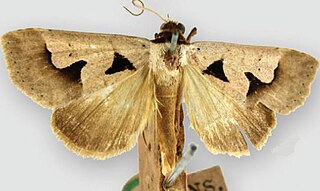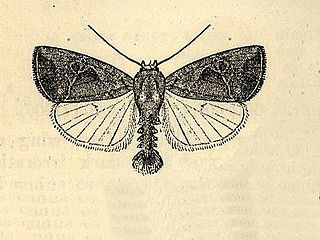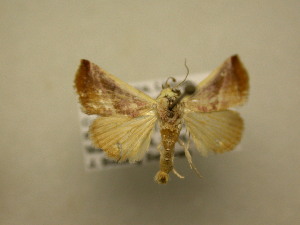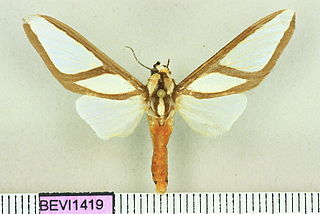
Baniana is a genus of moths of the family Erebidae. The genus was previously classified in the subfamily Calpinae of the family Noctuidae.

Baniana minor is a species of moth of the family Erebidae. It occurs in open woodland/grassland scrub habitats in southeastern Arizona and also occurs, probably in similar habitats in the Guanacaste Province in Costa Rica.

Baniana significans is a species of moth of the family Erebidae. It is found in Cuba and Santo Domingo.

Baniana gobar is a species of moth of the family Erebidae first described by Herbert Druce in 1898. It is found in Mexico.

Elaphria nucicolora, the sugarcane midget, is a moth of the family Noctuidae. The species was first described by Achille Guenée in 1852. It is found from the south-eastern United States, through Guadeloupe, Jamaica and Puerto Rico to tropical South America. It is also present on the Hawaiian islands of Oahu, Maui and Hawaii.
Phyprosopus tristriga is a moth of the family Noctuidae first described by Gottlieb August Wilhelm Herrich-Schäffer in 1868. It is endemic to the Antilles, including Dominica, Cuba and Puerto Rico.

Elaphria agrotina is a moth of the family Noctuidae first described by Achille Guenée in 1852. It is found from North America, through Central America, the Antilles and Cuba to Brazil and Argentina.
Correbidia terminalis is a moth in the subfamily Arctiinae. It was described by Francis Walker in 1856. It is found from Mexico through Central America and Cuba and Puerto Rico to South America.

Eublemma cinnamomea is a species of moth of the family Erebidae first described by Gottlieb August Wilhelm Herrich-Schäffer in 1868. It is widespread in the New World tropics from the southern United States south to Argentina.

Robinsonia dewitzi is a moth in the family Erebidae first described by Juan Gundlach in 1881. It is found in Mexico, Costa Rica, Guatemala, Trinidad, Cuba, the Dominican Republic, the Guyanas, Brazil, Venezuela, Paraguay, Peru and Ecuador.
Leucania inconspicua is a moth of the family Noctuidae first described by Gottlieb August Wilhelm Herrich-Schäffer in 1868. It is found in Florida, Cuba, Puerto Rico, Jamaica, the Lesser Antilles and from Mexico to Brazil.
Melipotis famelica is a species of moth in the family Erebidae first described by Achille Guenée in 1852. The species is found from the southern United States to the Caribbean and Paraguay.
Cobubatha metaspilaris is a moth of the family Noctuidae, described by Francis Walker in 1863. It is found in the southern United States, British Virgin Islands and Cuba.
Eulepidotis modestula is a moth of the family Erebidae first described by Gottlieb August Wilhelm Herrich-Schäffer in 1869. It is found on Saint Kitts, Dominica, Grenada, the Bahamas, Jamaica, Cuba, Puerto Rico, St. Croix, as well as in Ecuador.
Eublemma recta, the straight-lined seed moth, is a moth of the family Erebidae. The species was first described by Achille Guenée in 1852. It is found in the United States from South Carolina to Florida and west to Texas. It is also found south to Argentina, on Cuba, Jamaica and Puerto Rico.
Melipotis januaris, the January melipotis moth, is a species of moth in the family Erebidae. It was first described by Achille Guenée in 1852. The species has a wide range in the New World and has been recorded from Saint Kitts, Montserrat, Dominica, Saint Lucia, Saint Vincent, Grenada, the Greater Antilles, Florida and from Mexico to Paraguay.
Horama pennipes is a moth in the subfamily Arctiinae first described by Augustus Radcliffe Grote in 1866. It is found on Cuba.
Horama diffissa is a moth in the family Erebidae first described by Augustus Radcliffe Grote in 1866. It is found in Cuba and Haiti.
Epidromia lienaris is a moth of the family Erebidae first described by Jacob Hübner in 1823. It is found from southern Florida and Arizona southward through the Caribbean and Central America to Peru and Brazil and the Galápagos Islands.

The Anobinae are a subfamily of moths in the family Erebidae described by Jeremy Daniel Holloway in 2005. Common morphological characteristics of Anobine moths include a dark head and prothoracic collar, lighter color on the thorax, and either bipectinate antennae or antennae with flagellomeral setae in males.







